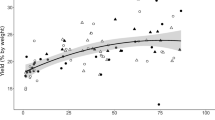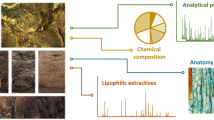Abstract
Tree species vary in properties because of the chemical nature of their respective extractive components. So it is that some species yield sufficient quantities of extractives to warrant their recovery for commercial uses. A number of such products, the most diversified of the forest products industries, is discussed here.
Similar content being viewed by others
Literature Cited
Anderson, A. B. Rosin and other extractives from ponderosa pine stumps. Paper Trade Jour.129(2): 35–37. 1949.
— and Gripenberg, J. Antibiotic substances from the heart wood of Thuja plicata D. Don. IV. The constitution of β-thujaplicin. Acta Chem. Scand.2: 644–650. 1948.
— and Runckel, W. J. Utilization of resinous wood in hardboard. Jour. For. Prod. Res. Soc.2(5): 76–80. 1952.
—. Pinitol from sugar pine stump wood. Ind. & Eng. Chem.45(3): 593–596. 1953.
Anonymous. Cinchona in Guatemala. U. S. Dept. Agr., For. Agr. April 1948.
-. [U. S. For. Serv., Bur. Ent. & Plant Quar., and Bur. Plant Ind.]. A naval stores handbook. U. S. Dept. Agr., Misc. Publ. 209. 1935. p. 36–59, 147–166.
-. Review and outlook, naval stores. U. S. Dept. Agr., Bur. Agr. Econ. 1951. [p. 10].
-. Ibid. [p. 21–24].
Benson, H. K. Chemical utilization of wood. U. S. Dept. Comm., 22nd Rep. Nat. Comm. Wood Util. 151 pp. 1932. [p. 103–106].
Buchanan, M. A. The tannins and coloring matters. In: Wise, L. E., and E. C. Jahn, Wood chemistry. Vol. 1. Chap. 15. 1952. [p. 624].
-, The tannins and coloring matters.In: Wise, L. E., and E. C. Jahn, Wood chemistry. Vol. 1. Chap. 15. 1952. [p. 622-626].
-, The tannins and coloring matters.In: Wise, L. E., and E. C. Jahn, Wood chemistry. Vol. 1. Chap. 15. 1952. [p. 628-636].
Dorman, K. W., and Clements, R. W. Results of commercial scale chemical stimulation tests. Part I. Naval Stores Rev.56(38): 12–14, 16. 1946.
—, and —. Results of commercial scale chemical stimulation. Part II. Naval Stores Rev. 56(40): 7–8. 1947.
Erdtman, H., and Gripenberg, J. Antibiotic substances from the heart wood ofThuja plicata D. Don. II. The constitution of γ-thujaplicin. Acta Chem. Scand.2: 625–638. 1948.
—. Die phenolischen Inhaltsstoffe des Kiefernkernholzes, ihre physiologische Bedeutung und hemmende Einwirkung auf die normale Aufschliessbarkeit des Kiefernholzes nach dem Sulfitverfahren. Ann. Chemie539: 116–127. 1939.
—. Organic chemical research in the Department of Organic Chemistry, Royal Institute of Technology, Stockholm, during the years 1945–1950. Svensk. Kem. Tidsk.63: 48–51. 1951.
Farmer, R. H., and Campbell, W. G. Chemical utilization of tropical hardwoods. TAPPI 35(4) (Tech. Sect.): 181–183. 1952.
Flinn, E. S. Wood tannins.In: Nature of the chemical components in wood. TAPPI Mono. Ser.6. Chap. 7. 1948. [p. 147].
— Wood tannins.In: Nature of the chemical components in wood. TAPPI Mono. Ser.6. Chap. 7. 1948. [p. 146].
Freeman, Mary F. Continuous flash type still may revolutionize the industry. Naval Stores Rev.56(52): 16–17. 1947.
Freudenberg, K. Die Chemie der Naturalichen Gerbstoffe. 1920.
Gripenberg, J. Antibiotic substances from the heart wood ofThuja plicata D. Don. III. The constitution of α-thujaplicin. Acta Chem. Scand.2: 639–643. 1948.
Guenther, E. Recent developments in essential oil production. Econ. Bot.6(4): 355–378. 1952. [p. 362–364].
— Recent developments in essential oil production. Econ. Bot.6(4): 355–378. 1952. [p. 372–373].
—The essential oils. Vol. 4: 257–328. 1950.
Harris, G. C. Wood resins. In: Wise, L. E., and Jahn, E. C, Wood chemistry. Vol. 1: 607. 1952.
Hepting, G. H. Stimulation of oleoresin flow in pines by a fungus. Science105: 209. 1947.
Howes, F. N. Vegetable gums and resins. 1949. [p. 85–89, 115–148].
-.Ibid. [p. 141].
-.Ibid. [p. 3–44].
-.Ibid. [p. 162–165].
Humphrey, I. W. Solvent refining of wood rosin. Ind. & Eng. Chem.35: 1062–1067. 1943.
Kurth, E. F. The volatile oils.In: Wise, L. E., and Jahn, E. C, Wood chemistry. Vol. 1: 574. 1952.
-.Ibid. [p. 579].
-.Ibid. [p. 568].
-. The Timberman: 116–117. March, 1952.
Lackey, H. B., Moyer, W. W., and Hearon, W. M. A new method of isolating coniden drin from sulphite waste liquor. TAPPI32(10): 469–471. 1949.
Mantell, C. L. The natural hard resins— Their botany, sources and utilization. Econ. Bot.4(3): 203–242. 1950. [p. 237-241].
—. The water-soluble gums—Their botany, sources and utilization. Econ. Bot.3(1): 3–31. 1949. [p. 17–18].
Marriott, F. G., and Greaves, C. The chemical utilization of wood. Dept. Int., Ottawa, Canada. 1935. [p. 266–267].
Merck Index, 6th ed. 1952. [p. 906].
Ibid. [p. 114].
Mirov, N. T. The terpenes (in relation to the biology of the genusPinus). Ann. Rev. Biochem.17: 521–540. 1948.
Palmer, R. C. Turpentine and rosin from wood wastes by the steam and solvent process. Ind. & Eng. Chem.26: 703–706. 1934.
Panshin, A. J., Harrar, E. S., Baker, W. J., and Proctor, P. B. Forest products. 1950. [p. 469–477].
-, -, -, and -.Ibid. [p. 479–481].
-, -, -, and -.Ibid. [p. 511–513].
-, -, -, and -.Ibid. [p. 454–467].
-, -, -, and -.Ibid. [p. 505–508].
Pew, J. C. A flavone from Douglas-fir heartwood. Jour. Am. Chem. Soc.70: 3031–3034. 1948.
Pomeroy, K. B. Modern trends in an ancient industry. Jour. For.50(4): 297–299. 1952.
Shearon, W. H. Chemical industry in western South America. I. Paraguay, Uruguay, Chile, Bolivia. Chem. & Eng. News31(37): 3736–3741. 1953.
Stamm, A. J., and Harris, E. F. Chemical processing of wood. 1953. [p. 477–479].
-, and -.Ibid. [p. 435–437].
Wagner, H. B. World trends in supplies, distribution and prices of naval stores, 1934–49. U. S. Dept. Agr., Prod. & Market. Admin., July, 1950. 95 pp. [p. 7].
-.Ibid. [p. 11–18].
Warth, A. H. The chemistry and technology of waxes. 1947. [p. 99–108].
Author information
Authors and Affiliations
Rights and permissions
About this article
Cite this article
Anderson, A.B. Recovery and utilization of tree extractives. Econ Bot 9, 108–140 (1955). https://doi.org/10.1007/BF02898793
Issue Date:
DOI: https://doi.org/10.1007/BF02898793




